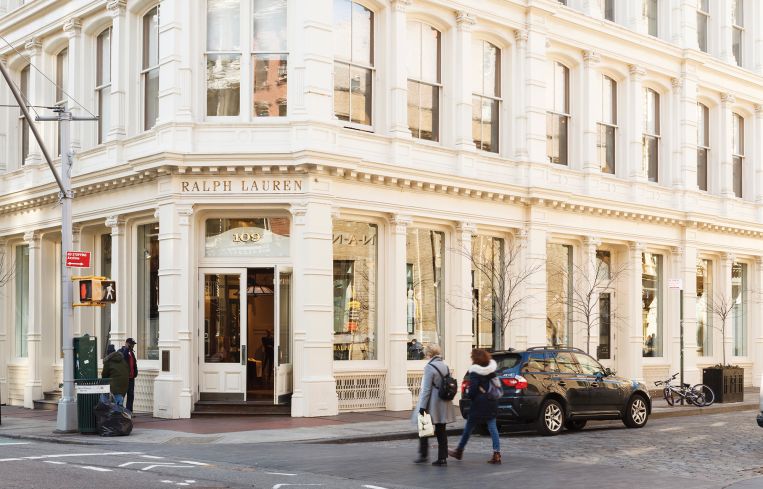Why a SoHo Storefront Had Two Iconic Companies Willing to Pay Top Dollar
The story behind Ralph Lauren and LVMH's battle for 109 Prince Street is the story of so much going on in retail right now
By Lois Weiss May 19, 2025 1:00 pm
reprints
Ralph Lauren’s $132 million purchase in late April of its longtime SoHo store at 109 Prince Street is just one more example of retailers paying more to not only control their own destiny but to also remain in SoHo.
“There’s a new purview — the way retailers are looking at real estate,” said Robert Cohen of Newmark, who represented the fashion firm. “It’s now a long-term view, and they no longer think in cycles of five, 10 or 15 years.”
SoHo is also a geographically limited global shopping destination bounded by Houston Street on the north with Canal on the south, and running from Broadway to West Broadway. The area has beautiful, historic architecture reminiscent of Europe’s best cities, and those that can nail down their forever home are now doing so — paying more to either own or rent.
“In a post-digital era where authenticity and permanence matter more than ever, owning your storefront in one of the world’s most storied shopping districts sends a clear message: This brand is here to stay,” said Jared Epstein of owner Aurora Capital Associates. “Foot traffic in SoHo isn’t just high, it’s influential. It’s the art director, the tourist, the tastemaker, the editor and the collector — all in one afternoon.”
The size of the stores is also scaled to the neighborhood and maintains the European charm. “There are tourists all over the place and a lot of shopping bags,” said retail broker Christopher Owles of Sinvin.
Cohen, who was involved in Ralph Lauren’s initial transaction, added, “They fell in love with the corner 15 years ago.” About 36 months ago, facing a 2026 lease expiration, the brand decided to see if buying the store made sense, Cohen said. But getting to yes took “persistence,” he added. “It took a while to get the answer we needed.”
That’s because Swiss investor and art financier Jean-Pierre Lehmann owned the handsome building for over 30 years. He bought the 20,000-square-foot historic cast-iron property on the northeast corner of Greene Street in 1991 for $3 million, completely renovating the French Renaissance-style white structure that is now part of the SoHo-Cast Iron Historic District.
Lehmann converted the loft building in 1997 into a live-work artist condominium with retail on the ground and second floors, lower level and cellar, plus three upper-floor residences and a roof deck. The art investor still owns two of the residences.
Ralph Lauren leased the ground and lower levels of one retail lot in 2010, while the second floor was leased to restaurateur Jean-Georges Vongerichten for an office.
The ground-floor lot has 3,258 square feet with a retail-friendly, 16-foot-high ceiling and access to a cellar spanning 3,386 square feet. The second-story retail condo has 3,265 square feet for a total of 9,909 square feet, putting the recent sale at a sky-high $13,321 per square foot.
“The numbers are far above what anyone thought it could command,” said Owles about the Ralph Lauren purchase. “Most places in SoHo are still a steal compared to the uptown buildings.”
A decade ago, Adelaide Polsinelli of Compass tried to sell the Ralph Lauren and Jean-George retail condos for $54 million with no takers. Then pricing spiked before dropping during the pandemic.
“All the owners are now asking 4 and 5 caps,” her son, Trystan Polsinelli of Compass, said, referring to capitalization rates, or the return on investment. He said there are now several properties quietly being shopped. “They have shifted back to pricing at the height of the market in 2018 and 2019.”
Cohen declined to discuss the specifics, but agreed the Ralph Lauren pricing was more about cap rates than its price per foot. Plus, he observed, “When you look at SoHo, the best corners are at Greene and Prince, and it is arguably the epicenter of SoHo.” Apple is directly across Greene Street with Louis Vuitton on the southeast corner. Shoe store Camper on the southwest corner purchased its 110 Prince Street location in 2008 for $16 million.

Back in 1996, Cohen and Robert K. Futterman represented art collector and investor Peter Brant, then the owner of 575 Broadway, in a lease with Prada, a spot which the Italian company just renewed. “Prada had the vision that they wanted to be down there as they were tied to the artists,” Cohen explained. “That was the first luxury deal.”
After that, the art galleries and the restaurants started to get cast aside for retailers while investors paid more for buildings. A deal by Jeff Sutton, A&H Acquisitions, Aurora Capital Associates and Thor Equities in 2012 to buy 529 Broadway for a then-neighborhood record $147.9 million was reinforced when Nike leased 52,000 square feet in the redeveloped property at a reported $16 million a year in rent.
But things weren’t so good during the pandemic when tourism stopped cold and retailers were barely allowed to open to the rare, masked visitor — who sometimes robbed them — while begging for lower rents. Many shuttered while building owners made previously unthinkable short-term deals, hoping foot traffic would pick up and entice retailers to extend their stays.
It became a rare opportunity to acquire stores at a discount. A retail co-op at 132 Spring Street with 5,041 square feet on the ground, mezzanine and lower levels sold for $8.45 million in June 2022.
In March 2023, as New York recovered from the pandemic, vacuum magnate James Dyson’s family office, Weybourne Holdings, paid $60 million for the 14,600-square-foot retail space being vacated by Dolce & Gabbana at 155 Mercer Street, equating to $4,110 a square foot from ASB Real Estate and Thor Equities. Dyson got a bargain, as the price was $32 million less than the sellers had paid in 2016.
The deal electrified the city’s real estate industry while their eyes filled with dollar signs.
Months later, in August 2023, Vornado sold 148-150 Spring Street for $15 million. A year after that, in September 2024, Caudalie paid $9.7 million for a small store at 130 Greene Street. The same space had sold for $16.55 million in 2014 and $8 million in 2021.
By October 2024, Mango founder Isak Andic paid $26.9 million for the 20,000-square-foot retail condo occupied by clothing retailer Cotton On at 512 Broadway. That November, a Japanese company bought the Cartier building at 102 Greene Street for $46 million.
Also, in October, Acadia Realty Trust bought 92-94 Greene Street for $43 million and then dropped $25.41 million in January 2025 for two stores with 9,700 square feet — equating to $2,577 per square foot — in the base of 73 Wooster Street. Mochino is leaving one store, which was already leased to John Varvatos at the time of the sale, Owles said.
With the pandemic in the rearview, more retailers have been scrambling for a better foothold. Ralph Lauren, for instance, had to battle LVMH for 109 Prince Street. LVMH has been trying to get a more prominent place for its Tiffany brand, which has a store at 93 Greene Street.
“Tiffany wanted something splashier, but it’s hard to find a 6,000-square-foot space in general,” said Owles.
Referring to LVMH CEO Bernard Arnault, Cohen noted, “Not that they have a terrible home — they just don’t have a corner. Mr. Arnault is a savvy real estate investor and will find something for them.”
Over the last few years, Tiffany has tried to elbow into at least two other places, to no avail. First it wanted to lease the 3,700-square-foot former Nespresso at 92 Prince Street on the southeast corner of Mercer Street from Marx Realty only to be outbid by Ferrari, which signed a lease in February 2024.
When Ferrari cut its deal, CBRE was reporting average retail rents of $1,060 per square foot in SoHo with 16 deals totaling 108,000 square feet signed in the third quarter of 2023 — more deals than in any other retail area in the city — with another seven in the first quarter. By the first quarter of 2024, rents averaged $1,073 per foot.
Among the deals last year was a 30,000-square-foot lease by Banana Republic at 515 Broadway, a small one for Dolce Vita at 489 Broadway and a 20,000-square-foot lease with Cotton On at 512 Broadway.
Most of SoHo’s larger stores are along Broadway. This May, Los Angeles Apparel — owned by Dov Charney, who founded American Apparel — leased a long-vacant 27,000-square-foot storefront at 480 Broadway from KPG Funds.
Avison Young is marketing a five-story building at 535 Broadway for $24 million that was purchased in December 2023 for $23.04 million and with the store now leased to Pop Mart.
Apple was also forced to defend its expiring 24,434 square feet at 103 Prince Street from Tiffany, with Apple “overpaying” for a renewal, as one area broker confided. Crown Acquisitions, Centurion Realty and Imperium Capital bought that property already leased to Apple in 2011 for $70.85 million and refinanced in 2020 for $75 million.
Chanel has also been trying to expand. Chanel signed its original lease for the entire corner of 139 Spring Street that wraps onto the quaint, cobblestoned Wooster Street in December 1999. The building became an artist loft condominium, and in 2016 the retail was sold to Invesco for $122 million. Chanel renewed in 2020 for a reported $3.6 million annual rent.
Valentino moved next door to 135 Spring under a two-year deal in 2021. But as consumers returned post-pandemic, Chanel wanted to expand into that space. Valentino was bumped out in July 2023 and reopened at 98 Prince Street in February 2024.
But Chanel and Valentino’s spaces were not only owned by different entities but also separated by the lobby for the upstairs artist lofts at 139 Spring. Ultimately, Chanel gave up on the expansion and moved to a temporary space at 120 Wooster Street while its corner home is being renovated.
That left 135 Spring without a tenant. That is, until Adidas wanted to relocate from 115 Spring Street. Both spaces were owned by SL Green Realty and represented by Newmark. A deal was made for Adidas at No. 135 at over $3 million per year for 4,424 square feet on the ground and 4,294 square feet on the lower level — a blended rent of around $360 per foot.
In April, Estée Lauder Companies leased four adjacent shops from 120 through 126 Prince Street, which the cosmetics company plans to run as separate boutiques for its different brands, at a rent of around $1,100 per foot.
Retailers are still being drawn to SoHo from other countries and states. Most recently, furniture maker Orior out of Northern Ireland landed at 32 Mercer Street while Swedish fashion house Toteme is nearby at 49 Mercer Street. The Israeli bridal shop Galia Lahav opened at 155 Wooster Street just south of Houston Street; the Italian conglomerate Oniverse leased 121 Wooster for its first U.S. store for its Antonio Marras brand; and the San Francisco company Thuma brought its mattresses and a café to 99 Wooster near Spring Street.
Asking rents are in the mid-$200s a foot on that Wooster block, said Owles, who has deals pending at 117 Wooster Street for the former Ted Baker store and another for the former Bravissimo space on the West Broadway side of the same building.
“In an unpredictable retail environment, SoHo has proven to be remarkably durable,” Epstein said. “Its mix of legacy charm and ever-evolving creativity draws both global spenders and local connoisseurs. That resilience is exactly why brands like Ralph Lauren are buying, not just to do retail sales, but to root themselves in the DNA of downtown New York.”



